***THIS POST HAS BEEN UNEDITED TO PRESERVE AUTHENTICITY***
We left Bumthang today, having recovered sufficiently from our serious walk yesterday. It is about an eight hour drive from Bumthang to Mongar, where we currently are.
We left around 9:30 this morning, and drove all day. It was raining for about the first 3 hours, so we didn't get to get out and look around at the point in between the two valleys, which is at 3700 meters (the highest we've been on the trip so far).
When we began descending, though, the weather cleared up, and even got sunny towards the end. The degree to which the weather and general climate differs by valley here is astounding. One minute, you can be in a rainy section of pine forest, and then ten minutes later, after cresting a ridge, it might be ten degrees warmer, and there will be moss hanging from the trees that appear almost tropical.
We stopped at a restaurant to eat the packed lunch we had taken with us from the hotel in Bumthang at one point, around 1:30. We sat at one of their tables eating our food in their restaurant while they watched what appeared to be Indian soap operas. One of the men stared at me the entire time we were in there, looking down only to scoop up food from his own lunch.
Earlier in the day, we had started listening to the music on driver Tashi's USB, which was a eclectic mix of Bhutanese tunes, Bollywood dance numbers, and western music ranging from Lady Gaga to Green Day. It turned out that driver Tashi's USB had near 160 songs on it. When I asked why we hadn't put it in sooner (seeing as we had heard Dead or Alive probably 15 times now), they told me that they weren't sure if I would like the Bhutanese and Nepali music that was mixed in. I told them that it wasn't like I got to hear Nepali music back home, so for sure I was good with it. It was nice to hear something else after nothing but one Bon Jovi cd and one AC/DC cd on repeat for the last 12 hours of driving we have done.
A few hours later, we stopped for tea wen we saw some benches on the side of the road. As we were preparing our tea, we heard the rhythmic beating of a drum and the clash of cymbals. Tashi said that this was coming from the nearby house, and was some kind of local animism ritual meant to ward off evil spirits. He went inside and asked if we could come watch. The people, being friendly like nearly all Bhutanese, allowed us in, no problem.
When we entered the house, we found it to be full of incense smoke and people. The house was probably no more than 20 feet by 20 feet, but there were 3 women, 5 small kids, one grown monk, and one younger monk as well. There, I witnessed the most authentic and bizarre ritual I have ever seen. Not that I've seen many ward-off-evil-spirit rituals in my life.
There were, on the ground, the likeness of different evil spirits fashioned out of ground up corn, some with candles burning in front of them. All of the people inside were gathered around, and were throwing handfuls of corn kernels at them and saying something in their local dialect of Dzongkha. Tashi explained that it was something to the effect of, "go," and was an attempt to banish the evil spirits from the household. All the while, the monk was reciting passages of scripture relevant to the ceremony.
Tashi and I took seats on an empty mat and observed for a few minutes, until the monk came to a break in the scripture. Everyone came over and crowded around me, saying hello in Dzongkha, and the kids looked on with the fascination that I have come to expect. Out here, though, the people are even less used to having visitors, so I may well have been the first white person some of them had seen. Remember that this was in the middle of nowhere, in between two rural towns that are also in the middle of nowhere.
After hellos, one of the women hurried off, and returned quickly with a small and intricately engraved container. She started saying something to Tashi, to which he laughed and translated. He told me that since I was a guest, they had brought me some local wine that they had made themselves. Tashi couldn't have nay because he was driving, but there was nothing stopping me, he said.
I was quickly handed a bowl, which the woman filled until it was close to overflowing. Everyone looked on expectantly. I smiled at them and took a sip. It wasn't bad, for alcohol made in the middle of nowhere by people who grew corn for a living.
As soon as I finished taking a drink, the woman that was holding the wine container leaned in and refilled by bowl. She proceeded to do this after the next four drinks I took, until I told her I couldn't have any more if she wanted me to walk out of her house on my own. Tashi translated, and everone laughed.
The ritual resumed, everyone began tossing corn at the effigies again, and the monk resumed his chanting, drum-pounding, and cymbal-banging. By the time the ritul was over for the day (they would resume again tomorrow, as it wasn't finished), I had had more than two bowls full of these people's so-called wine. I wouldfind out later that the woman constantly refilling my bowl had said to Tashi that she was impressed that I was still drinking after she refilled my bowl for the last time, and that I must be stronger than Bhutanese people since I was not drunk. So there I was thinking I was doing what was expected of me, when she had expected me to tell her I had had enough long before I did. Whoops.
Anyways, this "wine" was, it turned out, a lot stronger than it tasted. I had a pretty hard time getting out and back to the car, and when I reached the car, dropped into my seat, threw on my sunglasses, punched in the track number for Tiny Dancer, I was feeling pretty damn good.
The rest of the ride here (Mongar) was pretty good. We had put in the usb I loaded up with some things I thought Tashi square would like, based on the input they had given me, and I was quite drunk. Felt good, man.
Lesson learned from today? Beward alcohol offered by strangers, even if they are friendly, especially if you are unsure of the percentage of alcohol content.
Alright, I can't' do this anymore. I'm falling asleep as I type this. You've got pretty much everything of interest that happened today, though. Pease out compadres. Catch you on the flip side.
Saturday, May 29, 2010
Wednesday, May 05, 2010
Who's Gonna Show This Stranger Around?
Today was the first of our two full days in Bumthang (pronounced almost like boom-tong). We started the day by driving to the other side of the village, and from there we started hiking to a monastery that was built in the seventh century. It was an awesome hike, as it was really the first opportunity I've gotten to walk through a village, rather than driving through. I got to walk the same paths as the local people do, rather than just drive by in a car. I like doing things that way. When you leave, you feel like you got to have a more authentic experience. It feels less like you're walking around a big zoo, observing things from the outside, and more like you actually got to be a part of life there, instead. The monastery was awesome too, with its paintings that were hundreds of years old, its doorways build for people three-quarters my height, and setting that could have as easily been in 1500 as 2010.
Afterwards, we continued on our journey, and headed towards another monastery built upon the ground where one of the great figures in Buddhism in Bhutan meditated for three months. On the way to this monastery, we came across something interesting.
Marijuana grows all over the place in parts of Bhutan. It grows on the side of the roads, it grows in the forests, and it's cultivated in big fields right next to the rice and wheat. The local name for it in English is "pig wheat," because the farmers feed it to their pigs. Since the farmers want to make their pigs as fat as possible, they often feed it to them instead of more typical fare. When pigs eat marijuana, they want to eat more and more and more and get lazy, so that when they're not eating, they just go back to sleep, meaning less work for the farmers, and fatter pigs.
When we reached the monastery, Kurjey Lhakhang, we entered to find that the monks were currently gathered and participating in a chanting prayer, as it was a significant day on the calendar used in Bhutan. With the earthy incense, the rhythmic intonation of the monks, and the harsh shadows cast by the sole window, it made for quite an experience. It just seemed so real, and unlike most watered-down versions of things you typically get to see as a tourist. It was awesome.
Continuing our journey, we passed more tens of thousands of dollars worth of marijuana plants, and eventually reached the third monastery of the day, which turned out to be closed, so we decided to come back later in the day, because according to Tashi, there was some stuff that was worth seeing inside. We have a habit of showing up places and having them be closed.
At this point, we'd been out for around 3 hours, and walking for about two hours of that, but we still had another hour of walking to do to get to where we were getting picked up. We headed back along the road, passing through huge swaths of wild bamboo, past groups of grazing cattle, and down cobblestone pathways wending their way between houses and farm fields.
After we made our way back to the hotel for lunch and rested for a bit, we headed out once again to check out a few more local sites. We visited the local dzong first, which is different from many of the others we have seen in that it has never seen a battle. As all the other dzongs, it now serves only as the administrative center for the area and well as as a monastery, but even when it was originally built, it was never used in battle.
Next we crossed the river to return to the monastery we had visited earlier that had been closed. Thankfully, it was open this time. As we entered the main courtyard, we found a group of young monks performing the same kind of chant that we had seen at the previous monastery. I know I've said it a bunch of times, but I love just how authentic everything is here, and how close you can get to it all.
Inside we got to see paintings on the wall that date back to the 14th century that have never been restored. Most of the temples and dzongs have had their painting redone over the years, but this one has not. As a result, the paintings are pretty faded in some spots, but it was very cool to know that what we were looking at was the original, and was over 600 years old.
Finally, we drove to the Swiss Guest House. No typo.
About 30 or 40 years ago, a Swiss man was visiting the valley and fell in love with a woman who lived there. The two got married, and he has lived there ever since. He now owns a bunch of farmland, a hotel, a brewery/vineyard, and a facility that makes swiss cheese. When we went up to check the place out, it happened that Tashi had gone to school with the guy on duty at the hotel, so he showed us around and gave us free samples of Red Panda, the beer that they make there. I think it's cool to be in a country where you can travel halfway across it, and still run into people you know, consistently.
At this point it was about 5:30, so we headed back to the hotel, but there was still a bit of time before dinner, so I decided to walk down and watch a soccer match I had spotted as we were driving back. As I approached the sidelines, a bunch of kids came over, intrigued by my gorillapod. I showed them how it worked, and when they saw I had a camera, they asked to have their pictures taken. I happily obliged.
The kids here love having their pictures taken. When you show it to them after, they think it's hilarious. We stood around and talked until the match ended, at which point it looked like it was going to start raining, so everyone hurried home.
As I was walking back to the road, however, I saw a little girl lean out of the window of the car she was waiting in and start waving frantically at me. As I got closer, she, like all the other kids who notice me, started calling out "hi" and staring at me as if I was the guy from Twilight in an 8th grade classroom back home. I waved back and walked over toward her. As I approached the car, I saw that she was not alone. Her brother and sister were also in the car, and they all crammed into the window so they could get in on talking to this green-eyed white boy.
The girl asked me my name, which she repeated back as if she was testing out the sounds on her tongue for the first time. I guess the sounds in "Cameron" aren't too common in Dzongka. With surprisingly good English for a seven year-old from the countryside in Bhutan, she asked me where I was from. Then she told me I was beautiful, and buried her face in her hands while her siblings burst out laughing. When she had recovered sufficiently, she wanted to know how old I was, and what everyone in my family's name was. She hung off of every word as if I was giving her instructions on how to turn lead into gold.
Once she had asked me every question she could possibly think of, she said "thank you," gave me one final enormous smile, and started waving at me while saying "bye." This continued until I rounded the corner in the road and was out of view.
As I was on my way back to the hotel, I ran into another young kid who was probably around 11. Actually, he ran up to me. At first he was walking behind me, and I heard the sound of running as he tried to catch up to me, although I didn't know that's what he was trying to do at the time. As he did catch up, he crossed to the other side of the road, matched my pace, and started looking over at me tentatively every so often. He started whistling, so when he stopped, I echoed his tune. He started laughing, so I caught his eye and asked him if he spoke English.
It turned out he did. I asked where he lived and how far away his school was from his house. First, he told me that it was one kilometer, but then he changed his mind and told me it was one centimeter. He thought this was the funniest thing that had ever been said by anyone anywhere. We walked together for about twenty minutes, while he told me all about the village, his school, and his friends and family. It was fortunate that I ran into him, because he showed me things and taught me things I wouldn't have even known to ask about if it weren't for him. Eventually, we reached his house, where his sister was just getting back to at the same time. They walked up the hill together chattering away excitedly and glancing back every few seconds, smiling and waving the whole time.
I like this place.
Tuesday, May 04, 2010
Who-oah, We're Half Way There
Trongsa is about halfway between Paro (where I arrived) and Tashigang (which is as far east as we will be traveling). Because of this more-or-less middle location, it has historically been a very important place. It is the divide between the two halves of the country. From here, one could be close to every part of the country at once, making it an optimal place to rule from, and a key location to control.
Today we started with a walk around Trongsa Dzong. There were monkeys. Yes, monkeys. Monkeys performing feats that would shame Altair, Faith, . Rooftop-to-rooftop jumps, sliding down pipes, moving sideways along windowsills and jumping from one to the other, all of it.
After being stunned by the monkeys we headed out of the dzong to begin our trek of the day. Remember how I said to get to Trongsa you have to travel aaaaaaaaaalllllll the way around a bunch of mountains? Well, we were going to say to hell with that and walk all the way down to the bottom of the valley, and then all the way back up, thereby eliminating the need for the ridiculous detour. Of course, our driver would still have to drive the car to pick us up. So really nothing would be saved.
Today we started with a walk around Trongsa Dzong. There were monkeys. Yes, monkeys. Monkeys performing feats that would shame Altair, Faith, . Rooftop-to-rooftop jumps, sliding down pipes, moving sideways along windowsills and jumping from one to the other, all of it.
After being stunned by the monkeys we headed out of the dzong to begin our trek of the day. Remember how I said to get to Trongsa you have to travel aaaaaaaaaalllllll the way around a bunch of mountains? Well, we were going to say to hell with that and walk all the way down to the bottom of the valley, and then all the way back up, thereby eliminating the need for the ridiculous detour. Of course, our driver would still have to drive the car to pick us up. So really nothing would be saved.
It was hard. It took three hours. Two of those hours were going uphill. It was sunny. There was little shade.
After our hike, we headed... where else? Back to Trongsa for lunch. I cursed the foolish road and all of its twists and turns for taking so long to get us back to the city. Or at least, I would have, if I had had enough energy to do so. As it was, I kinda just sat in the car, feeling the breeze on my face, and feeling content with just sitting down.
Once we were fed and rested, we checked out the Ta Dzong, which is a watchtower that I guess if we're keeping the whole Minas Tirith thing, would be like the place that the guy jumped off of when he was on fire, right up at the top.
The day before, Tashi had told me he brought a few cds with him, which he had put in the glove box this morning. Since we were heading out for out next destination and had a long bit of driving ahead of us, I busted them out to find Cross Road by Bon Jovi sitting on top. Without hesitation, I put it into the cd player.
After our hike, we headed... where else? Back to Trongsa for lunch. I cursed the foolish road and all of its twists and turns for taking so long to get us back to the city. Or at least, I would have, if I had had enough energy to do so. As it was, I kinda just sat in the car, feeling the breeze on my face, and feeling content with just sitting down.
Once we were fed and rested, we checked out the Ta Dzong, which is a watchtower that I guess if we're keeping the whole Minas Tirith thing, would be like the place that the guy jumped off of when he was on fire, right up at the top.
The day before, Tashi had told me he brought a few cds with him, which he had put in the glove box this morning. Since we were heading out for out next destination and had a long bit of driving ahead of us, I busted them out to find Cross Road by Bon Jovi sitting on top. Without hesitation, I put it into the cd player.
And so, with Livin' on a Prayer providing the soundtrack, we left Trongsa and headed for Bumthang valley.
The drive was spectacular, as all drives here are, and we reached Bumthang around 5:30. Our hotel here, while substantially bigger, more aesthetically pleasing, and with a balcony, has continued the trend of decreasing amenities. This one has a wood-burning furnace in the room. Overall though, I would say it's an improvement over the last place. Not that I'm too picky about hotels. I mean, as long as I have a lock on the door, a bathroom of some kind, and no bed bugs, I'm good. But this place has a nice kind of country retreat feel to it. And it's got an amazing view of the surrounding valley.
The drive was spectacular, as all drives here are, and we reached Bumthang around 5:30. Our hotel here, while substantially bigger, more aesthetically pleasing, and with a balcony, has continued the trend of decreasing amenities. This one has a wood-burning furnace in the room. Overall though, I would say it's an improvement over the last place. Not that I'm too picky about hotels. I mean, as long as I have a lock on the door, a bathroom of some kind, and no bed bugs, I'm good. But this place has a nice kind of country retreat feel to it. And it's got an amazing view of the surrounding valley.
As I was sitting having dinner a little while ago, the owner came over and started talking to me about the standard stuff: where I was from, if this was my first time to Bhutan, how I liked it, etc. Then he told me I was very handsome, and asked me how old I was, while glancing over at the girls in the corner. When I told him I was twenty, he responded by shaking his head and saying, "oh, too young." He then turned his head to the two girls and said something in Dzongkha, of which the only word I caught was "twenty." He then explained that one of the girls was his daughter, but that I was too young for her, and it was a shame. Welcome to my life.
Monday, May 03, 2010
Ten Miles Behind Me, and Ten Thousand More to Go
The further east you move in Bhutan, the more, um, basic, the accommodations become. We only left Thimphu two days ago, but the hotel last night lacked internet, laundry services, a fridge, and the complimentary water that has been provided so far. Tonight's hotel continues this trend, with the hallways lacking any finish beyond concrete, and a padlock on the door. The room itself is basic but nice enough, with wooden walls that make it feel like being in a cottage back home or something like that. There is, however, a great view of the valley in which the town, Trongsa, is located.
To get here, we got up and going after what is becoming the typical breakfast: toast (with which, I am pleased to report, the hotel offered salted butter), eggs, tea, and cornflakes with hot milk. I know. Hot milk. It seemed pretty weird to me too, and I must admit, I was pretty worried the first time they told me they didn't have cold milk. When I asked for cold milk, the waiter just looked at me like I was crazy for wanting to eat something so ridiculous. My expression mirrored his. Reluctantly, I agreed to take the hot milk, and while it was certainly strange for someone who has lived for 20 years eating cereal with cold milk, it wasn't bad. It's kind of like eating oatmeal. But not.
Around 9:20 we hit the road for Trongsa. This was going to be nearly a full day of driving, and we were only going 200 kilometers. Back home that would have taken 2 hours (if that), but not in Bhutan. Since we were constantly going up mountains and down and around and on driving roads with potholes the size of baby cows, it took all day. I didn't mind though, because it was the best drive we've been on so far. I never get tired of coming over a crest and seeing mountains that go on forever and tiny clusters of houses and farms down below. It was raining in the morning, so there was heavy fog hanging everywhere. You know that scene in Star Wars Episode One where the Gungans ride out of the mist when they're going to do battle? Yeah, it was like that. Except that the things coming out of the fog were cars and huge dump trucks that only came into view about 30 feet from the front of the car.
At one point, we drove down into the part conservation area, part village of Gantey where black-necked cranes come in the winter. Obviously, being May, there were no cranes, but we got to see the village and the monastery there, which is the only Nyingmapa monastery in western Bhutan.
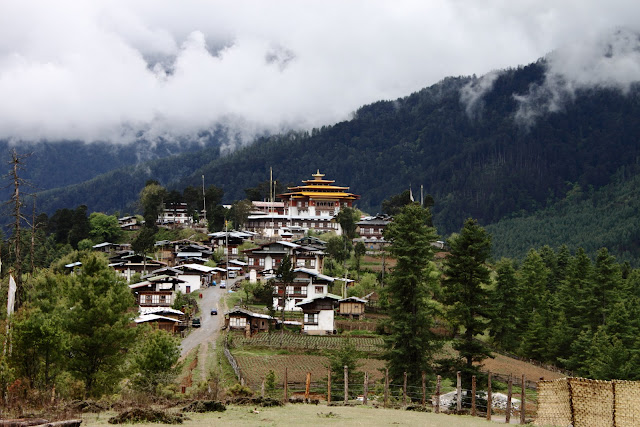
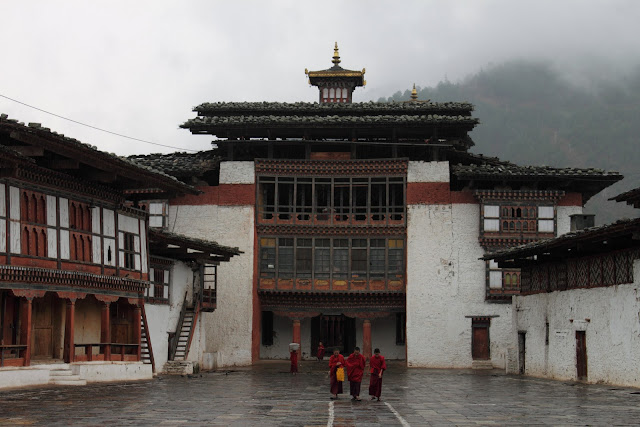

As I understand it, Nyingmapa is the sect of Buddhism that the people in eastern Bhutan follow. This major difference that Tashi pointed out to me between the two sects lies not in doctrine or scripture, but in the conduct of the monks. Under Nyingmapa, the monks are allowed to marry, are not required to wear the red robes that everyone relates to Buddhism, and they do not have to keep their hair buzzed short. I know that the monks in the picture do have short hair, and are wearing the red robes, but if they wished, they opt for a different style. They are given the option, and not forced either way.
As an interesting note, this valley also supposedly grows the best bamboo for arrow-making, so people from other parts of the country often come here to obtain the very best stalks.
Driving back out of the valley and onto the main road again, we continued on our way to Trongsa. About an hour and a half after getting back on this road, we had descended down low enough to be out of the fog, and it was here that I saw my first yak. It was just standing there on the side of the road, hanging out and eating grass. As you can see in the picture below, it wasn't exactly in the greatest position for picture-taking, but I tried. I couldn't let my first ever yak go by without taking a picture. I didn't want to get any closer than I was, because Tashi had told me that they're not as easygoing as cows, and are more wild. Unless they're used to your presence because you feed them or something like that, it's not a particularly good idea to approach a yak. You have been warned.

A few more hours after my run-in with the uncooperative yak, we reached Trongsa. Well, kind of. If you take reach to mean "got within view of," then we had reached it. Because it was on another mountain from the one we were on, we had to drive half an hour around to where the two mountains connected to get physically to the town.
Trongsa is like Minas Tirith: Bhutan Edition. It doesn't have a grid pattern of roads, or even a mess of jumbled roads that interconnect randomly like you find in a lot of places here. Due to the fact that it is built on a steeper mountain than most towns in Bhutan, it's mostly just one road that winds back and forth down the slope with buildings lining it where the slope permits. It's pretty cool.
At the bottom of the road is the local dzong as well as an archery range. Because of the tiered construction, you can see people sitting in their windows in the first two rows of buildings watching the archery matches below.
Once we had gotten settled in at the hotel, I decided to walk around a bit, and just about as soon as I stepped outside, I saw that there was a big crowd around the archery range. There was a match going on. I walked down to watch for a bit before dinner. Archery is a lively affair. There's lots of singing and chanting and cheering all the time. It makes for fun spectating. At first a lot of people turned around and stared at me, as they always do, but their interest soon turned back to the match, and some even shuffled over to make a spot for me.
Archery, like so many things in Bhutan, display the duality of its present society. The word anachronism comes to mind, and if I knew how to properly use it in a sentence, I would. The bows are the same competition-style bows you would find in North America, but everything else about the sport looks just as it likely did 100 years ago, or even 500 years ago. It's very cool.
To get here, we got up and going after what is becoming the typical breakfast: toast (with which, I am pleased to report, the hotel offered salted butter), eggs, tea, and cornflakes with hot milk. I know. Hot milk. It seemed pretty weird to me too, and I must admit, I was pretty worried the first time they told me they didn't have cold milk. When I asked for cold milk, the waiter just looked at me like I was crazy for wanting to eat something so ridiculous. My expression mirrored his. Reluctantly, I agreed to take the hot milk, and while it was certainly strange for someone who has lived for 20 years eating cereal with cold milk, it wasn't bad. It's kind of like eating oatmeal. But not.
Around 9:20 we hit the road for Trongsa. This was going to be nearly a full day of driving, and we were only going 200 kilometers. Back home that would have taken 2 hours (if that), but not in Bhutan. Since we were constantly going up mountains and down and around and on driving roads with potholes the size of baby cows, it took all day. I didn't mind though, because it was the best drive we've been on so far. I never get tired of coming over a crest and seeing mountains that go on forever and tiny clusters of houses and farms down below. It was raining in the morning, so there was heavy fog hanging everywhere. You know that scene in Star Wars Episode One where the Gungans ride out of the mist when they're going to do battle? Yeah, it was like that. Except that the things coming out of the fog were cars and huge dump trucks that only came into view about 30 feet from the front of the car.
At one point, we drove down into the part conservation area, part village of Gantey where black-necked cranes come in the winter. Obviously, being May, there were no cranes, but we got to see the village and the monastery there, which is the only Nyingmapa monastery in western Bhutan.
As I understand it, Nyingmapa is the sect of Buddhism that the people in eastern Bhutan follow. This major difference that Tashi pointed out to me between the two sects lies not in doctrine or scripture, but in the conduct of the monks. Under Nyingmapa, the monks are allowed to marry, are not required to wear the red robes that everyone relates to Buddhism, and they do not have to keep their hair buzzed short. I know that the monks in the picture do have short hair, and are wearing the red robes, but if they wished, they opt for a different style. They are given the option, and not forced either way.
As an interesting note, this valley also supposedly grows the best bamboo for arrow-making, so people from other parts of the country often come here to obtain the very best stalks.
Driving back out of the valley and onto the main road again, we continued on our way to Trongsa. About an hour and a half after getting back on this road, we had descended down low enough to be out of the fog, and it was here that I saw my first yak. It was just standing there on the side of the road, hanging out and eating grass. As you can see in the picture below, it wasn't exactly in the greatest position for picture-taking, but I tried. I couldn't let my first ever yak go by without taking a picture. I didn't want to get any closer than I was, because Tashi had told me that they're not as easygoing as cows, and are more wild. Unless they're used to your presence because you feed them or something like that, it's not a particularly good idea to approach a yak. You have been warned.
A few more hours after my run-in with the uncooperative yak, we reached Trongsa. Well, kind of. If you take reach to mean "got within view of," then we had reached it. Because it was on another mountain from the one we were on, we had to drive half an hour around to where the two mountains connected to get physically to the town.
Trongsa is like Minas Tirith: Bhutan Edition. It doesn't have a grid pattern of roads, or even a mess of jumbled roads that interconnect randomly like you find in a lot of places here. Due to the fact that it is built on a steeper mountain than most towns in Bhutan, it's mostly just one road that winds back and forth down the slope with buildings lining it where the slope permits. It's pretty cool.
At the bottom of the road is the local dzong as well as an archery range. Because of the tiered construction, you can see people sitting in their windows in the first two rows of buildings watching the archery matches below.
Once we had gotten settled in at the hotel, I decided to walk around a bit, and just about as soon as I stepped outside, I saw that there was a big crowd around the archery range. There was a match going on. I walked down to watch for a bit before dinner. Archery is a lively affair. There's lots of singing and chanting and cheering all the time. It makes for fun spectating. At first a lot of people turned around and stared at me, as they always do, but their interest soon turned back to the match, and some even shuffled over to make a spot for me.
Archery, like so many things in Bhutan, display the duality of its present society. The word anachronism comes to mind, and if I knew how to properly use it in a sentence, I would. The bows are the same competition-style bows you would find in North America, but everything else about the sport looks just as it likely did 100 years ago, or even 500 years ago. It's very cool.
Sunday, May 02, 2010
Across the Rainbow Bridge
Today we had a late start. And by late, I mean breakfast at 8:30. We loaded up the car and departed Thimphu along a winding mountain road riddled with sheer 500-foot drops, hairpin bends, and questionable paving. Oh, and like most of the other roads in Bhutan, there's only room for one and a half cars. And by cars I mean passenger vehicles, not the big flatbed trucks that are the more common sight in between towns.
We were headed to Punakha and Wangduephodrang, in what is, comparatively, the lowlands. As we crested the mountain range that separated Thimphu valley from Punakha valley, we stopped at the 108 stupa meant to bring good luck to those who pass by. Tashi said that later in the year, when the weather was clearer, you could see the Himalayas going on forever. As it was, there was fog obscuring even the bottom of the valley from view. I didn't mind too much, as this also made for some awesome pictures.
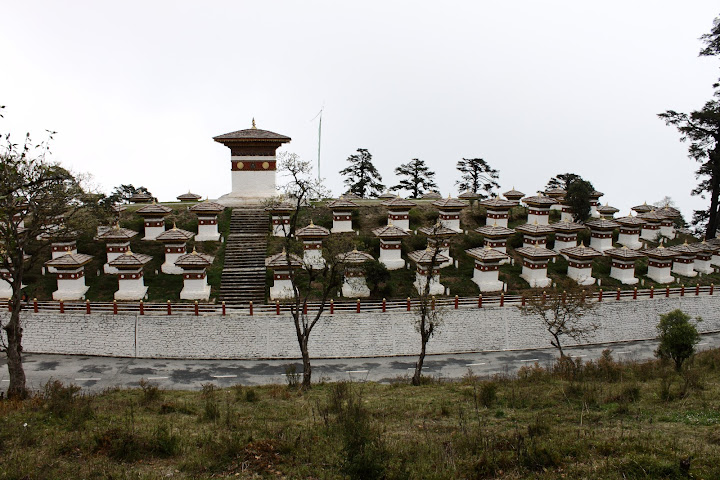
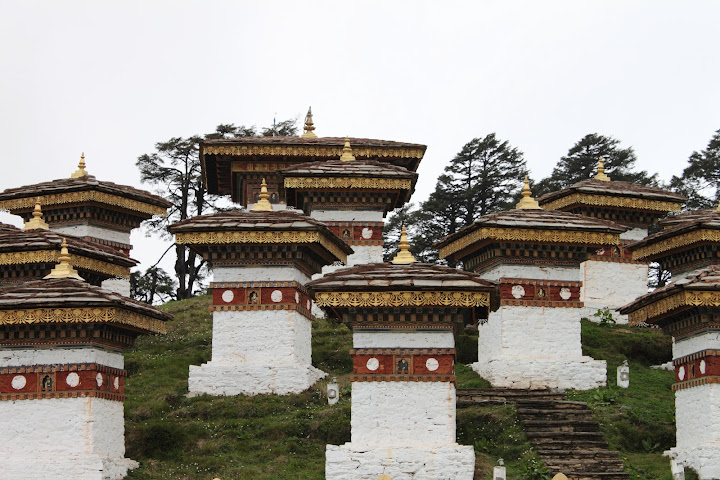
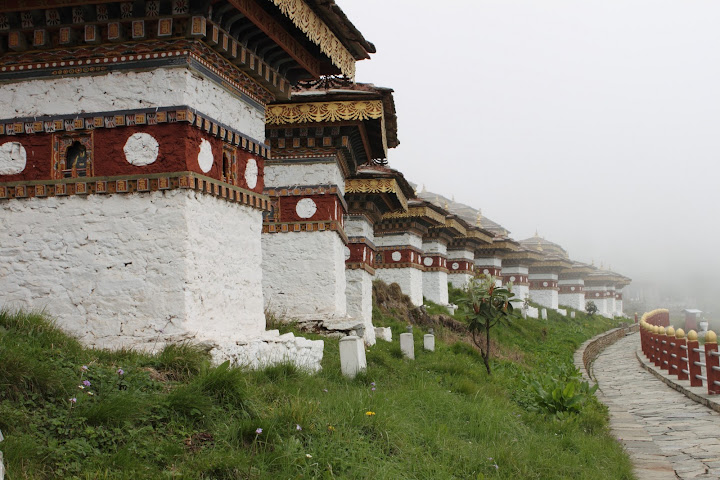
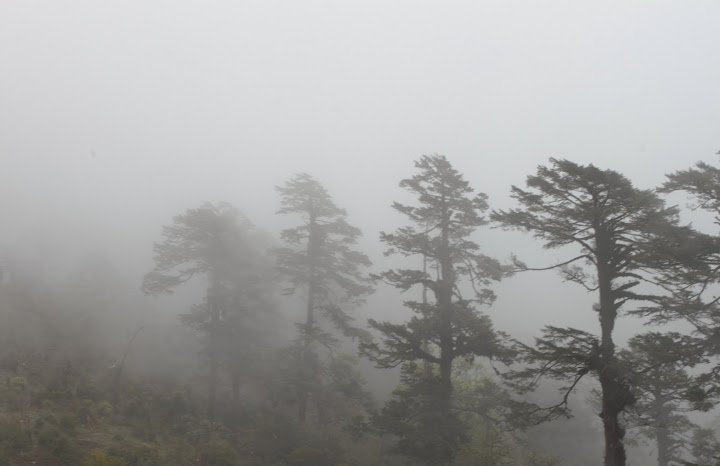
From there, we descended into the valley, and made our way to Chimi Lakhang, a fertility temple, where women who cannot bear children come to pray for help conceiving. It is said that if they sleep there overnight, they will be able to bear a child afterward.
Next we headed to Punakha Dzong, which had the biggest and most awesome interior I have seen yet. Sorry, no pictures allowed. There were statues inside that rose three stories up, and there was intricate detail on every single available surface, including the beams holding the roof up, which were adorned with dragons. There was seating for dozens of monks. Tashi told me that this was where the center of the monastic community came to live during the winters, when it grew colder in Thimphu. Because of the lower elevation, it was substantially warmer here. In Thimphu, I had worn my jacket when I wasn't hiking up somewhere, but down here I was wishing I had worn my shorts.
Finally, we hiked up to a massive stupa constructed at the time of the current king's birth.

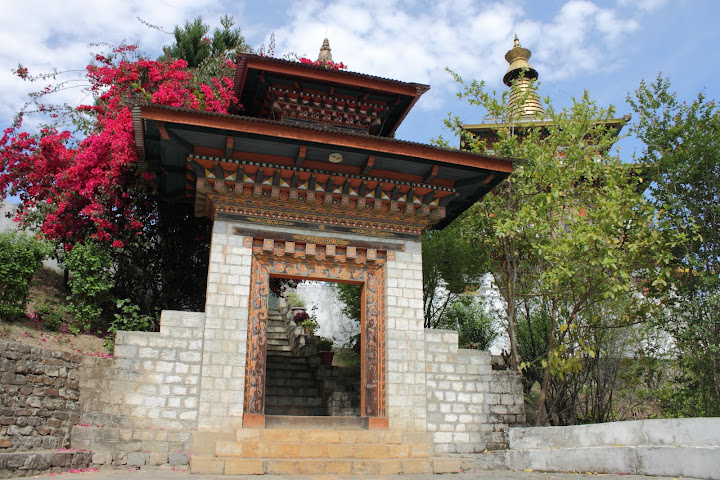
When the king was born, it was prophesied that the country would face tremendous hardship at some point during his reign unless a large stupa was constructed in this area, so in his name, it was built.
When we first arrived, we found the door to be locked, so Tashi pulled out his cell and called the number listed on a sign outside. It turned out the monk was in the middle of performing a ritual, and we couldn't come in just now. We waited a few minutes for him to finish, and he unbolted the door for us. I'm still always a little taken aback when I see a monk using a cell phone or drinking a Sprite. We made our way up to the top floor and outside onto the roof. The hike was definitely worth it. We had a spectacular view of the entire valley.
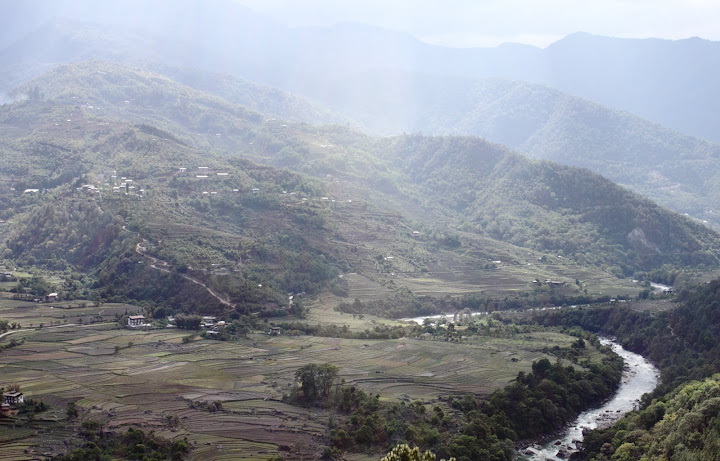
I mentioned how cool I thought the farms here were, being carved out in tiers from the hillside. I explained what farms were like back home, and we stood around talking about the differences between our two countries for a while. That's kind of become the way things go. Tashi teaches me something about Bhutan, and I tell him how different it is from home. He grew up here in Bhutan, so he doesn't find the method of farming that exciting, but when I told him that my mom grew up on a farm that was nearly 100 acres large, he was fascinated. He teaches me about Bhutan, and I teach him about Canada.
After a while, the monk came up to find us, wondering what we were doing up there that was taking so long, I'm sure. We had been up on the roof for near twenty minutes just talking and taking pictures. We made our way out and hiked along the river for a while back to our car. We passed a house where, when the four kids who lived there noticed me, started yelling "bye!" over and over and waving. I suppose they haven't gotten to learning "hi" yet. Or maybe bye is easier for them to pronounce. I'm not sure. Either way, I smiled, waved back, and said bye to them, but they didn't stop. They kept calling out to us until we were out of sight. Tashi and I looked at each other and laughed and carried on with our hike.
We eventually crossed a bridge covered with more prayer flags than I had seen on any bridge so far. It was quite a sight with all of the colors mixed in together and flying in the wind.
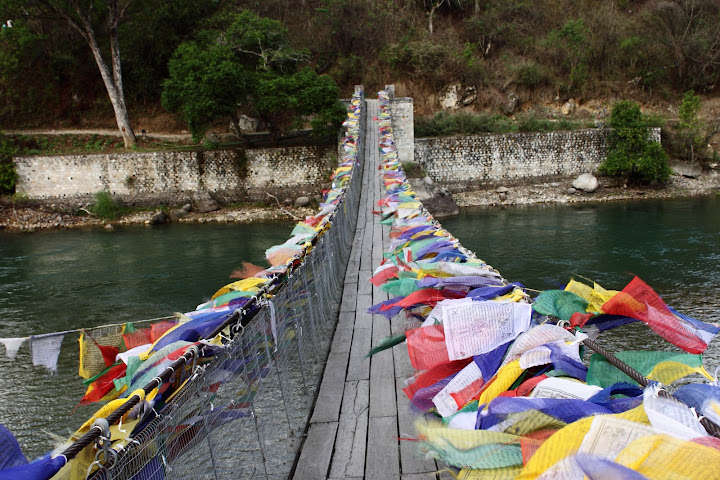
We drove to the hotel, ate dinner, and then collapsed, content with a day full of breathtaking views, beautiful sites, and the fact that we hadn't been killed in a head-on collision due to the fog.
We were headed to Punakha and Wangduephodrang, in what is, comparatively, the lowlands. As we crested the mountain range that separated Thimphu valley from Punakha valley, we stopped at the 108 stupa meant to bring good luck to those who pass by. Tashi said that later in the year, when the weather was clearer, you could see the Himalayas going on forever. As it was, there was fog obscuring even the bottom of the valley from view. I didn't mind too much, as this also made for some awesome pictures.
From there, we descended into the valley, and made our way to Chimi Lakhang, a fertility temple, where women who cannot bear children come to pray for help conceiving. It is said that if they sleep there overnight, they will be able to bear a child afterward.
Next we headed to Punakha Dzong, which had the biggest and most awesome interior I have seen yet. Sorry, no pictures allowed. There were statues inside that rose three stories up, and there was intricate detail on every single available surface, including the beams holding the roof up, which were adorned with dragons. There was seating for dozens of monks. Tashi told me that this was where the center of the monastic community came to live during the winters, when it grew colder in Thimphu. Because of the lower elevation, it was substantially warmer here. In Thimphu, I had worn my jacket when I wasn't hiking up somewhere, but down here I was wishing I had worn my shorts.
Finally, we hiked up to a massive stupa constructed at the time of the current king's birth.
When the king was born, it was prophesied that the country would face tremendous hardship at some point during his reign unless a large stupa was constructed in this area, so in his name, it was built.
When we first arrived, we found the door to be locked, so Tashi pulled out his cell and called the number listed on a sign outside. It turned out the monk was in the middle of performing a ritual, and we couldn't come in just now. We waited a few minutes for him to finish, and he unbolted the door for us. I'm still always a little taken aback when I see a monk using a cell phone or drinking a Sprite. We made our way up to the top floor and outside onto the roof. The hike was definitely worth it. We had a spectacular view of the entire valley.
I mentioned how cool I thought the farms here were, being carved out in tiers from the hillside. I explained what farms were like back home, and we stood around talking about the differences between our two countries for a while. That's kind of become the way things go. Tashi teaches me something about Bhutan, and I tell him how different it is from home. He grew up here in Bhutan, so he doesn't find the method of farming that exciting, but when I told him that my mom grew up on a farm that was nearly 100 acres large, he was fascinated. He teaches me about Bhutan, and I teach him about Canada.
After a while, the monk came up to find us, wondering what we were doing up there that was taking so long, I'm sure. We had been up on the roof for near twenty minutes just talking and taking pictures. We made our way out and hiked along the river for a while back to our car. We passed a house where, when the four kids who lived there noticed me, started yelling "bye!" over and over and waving. I suppose they haven't gotten to learning "hi" yet. Or maybe bye is easier for them to pronounce. I'm not sure. Either way, I smiled, waved back, and said bye to them, but they didn't stop. They kept calling out to us until we were out of sight. Tashi and I looked at each other and laughed and carried on with our hike.
We eventually crossed a bridge covered with more prayer flags than I had seen on any bridge so far. It was quite a sight with all of the colors mixed in together and flying in the wind.
We drove to the hotel, ate dinner, and then collapsed, content with a day full of breathtaking views, beautiful sites, and the fact that we hadn't been killed in a head-on collision due to the fog.
Subscribe to:
Posts (Atom)